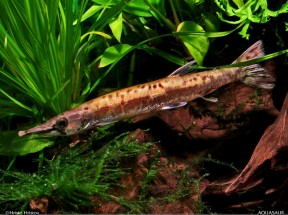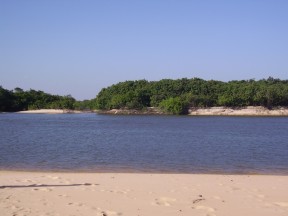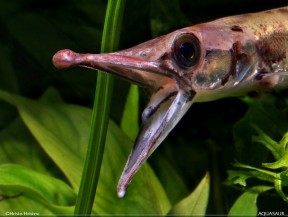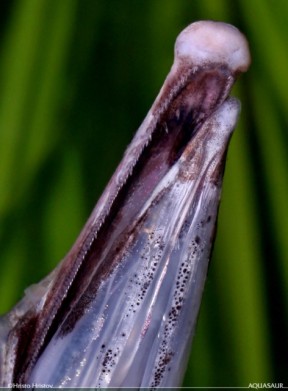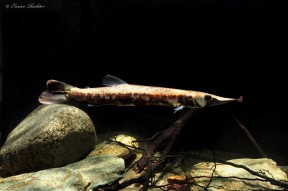Boulengerella lucius
SynonymsTop ↑
Hydrocynus lucius Cuvier, 1816 (with genus originally spelled as Hydrocyon).
Etymology
Boulengerella: named for Belgian-British zoologist George Albert Boulenger (1858-1937).
lucius: named for its resemblance to the northern pike, Esox lucius.
Classification
Order: Characiformes Family: Ctenoluciidae
Distribution
Cuvier gave type locality as ‘Brazil’, with modern records indicating it to range throughout the central Amazon region in Brazil and Río Orinoco in Venezuela.
Earlier records from the rio Tocantins in Brazil and coastal drainages of the Guianas apparently represent B. cuvieri, while those from the ríos Paraguay, Paraná and de la Plata in Paraguay and Argentina are also erroneous and may refer to an Acestrorhynchus sp.
Habitat
This species is pelagic and adults tend to be associated with main river channels and larger tributaries of both white and black water rivers as well as floodplain lakes.
Maximum Standard Length
The largest officially-recorded specimen measured 420 mm.
Aquarium SizeTop ↑
Suitable only for public installations or the very largest private aquaria.
Maintenance
Relatively unfussy although some surface cover in the form of floating or overhanging vegetation or branches is appreciated.
It does best if there is a high proportion of dissolved oxygen and moderate degree of water movement so external filters, powerheads, airstones, etc., should be employed as necessary.
As stable water conditions are obligatory for its well-being this fish should never be added to biologically-immature aquaria and weekly water changes of 30-50% aquarium volume should be considered mandatory.
A tightly-fitting cover is also essential as Boulengerella spp. are prodigious jumpers, and it may also prove beneficial to cover the back and sides of the aquarium in order to reduce the chances of it swimming into the glass since it can be skittish, especially in confined surroundings.
Water Conditions
Temperature: 22 – 28 °C
pH: 4.0 – 7.0
Hardness: 18 – 179 ppm
Diet
An obligate predator feeding mostly on smaller fishes and insects in nature but in most cases adapting well to dead alternatives in captivity.
Smaller specimens can be offered bloodworm, small earthworms, chopped prawn and suchlike while adults will accept strips of fish flesh, whole prawns/shrimp, mussels, live river shrimp, larger earthworms, etc.
Insects such as crickets or are also suitable to use although it’s best to fill the stomachs of these by feeding them fish flakes or some kind of vegetable matter before offering them to the fish.
Like the vast majority of predatory fishes this species should not be fed mammalian or avian meat such as beef heart or chicken.
Some of the lipids contained in these cannot be properly metabolised by the fish and can cause excess fat deposits and even organ degeneration.
Similarly there is no benefit in the use of ‘feeder’ fish such as livebearers or small goldfish which carry with them the risk of parasite or disease introduction and at any rate tend not have a high nutritional value unless properly conditioned beforehand.
Behaviour and CompatibilityTop ↑
Peaceful with anything too large to swallow and can be maintained in a community provided tankmates are chosen with care.
Aggressively territorial or very competitive species should be avoided with the best choices being similarly-sized fishes such as Cichla spp. and larger doradid or loricariid catfishes.
Other surface-dwellers are best avoided although some hobbyists report success keeping it alongside the related Acestrorhynchus spp.
This species is not aggressive towards conspecifics with juveniles in particular exhibiting a marked schooling instinct.
Older individuals tend to be more solitary but still group together from time-to-time, and it’s best maintained in numbers of four or more.
Reproduction
Unrecorded.
NotesTop ↑
This species is largely unsuitable for the home aquarium given its eventual size and natural behaviour, and we know of only a handful of private aquarists with the facilities required to house it long-term.
Nonetheless juveniles and subadults are sometimes available in the trade although often misidentified as the congener B. maculata.
The entire dorsal-fin base is located anteriorly to a vertical through the anal-fin origin and this character distinguishes it from all other ctenolucids except B. cuvieri and B. xyrekes.
B. lucius differs from both B. cuvieri and B. xyrekes in lacking (vs. possessing) a dark spot at the base of the median caudal-fin rays, with the membranes of the median rays instead being dark at the base, forming a series of horizontally-orientated dark patches between the rays.
It can be further told apart from both species by absence (vs. presence) of a dusky, somewhat diffuse lateral stripe and presence (vs. absence) of randomly-distributed dark spots on the ventrolateral surface of the body, from B. cuvieri by possessing 45-46 (vs. 48-49) vertebrae, and from B. xyrekes by absence (vs. presence) of an oblique stripe on the posteroventral portion of the third infraorbital, possession of 98-117 (vs. 87-94) lateral line scales and 62-72 (vs. 54-63) predorsal scales.
Boulengerella differs from Ctenolucia, the only other genus currently contained in the family Ctenolucidae, by a series of derived features including possession of 87-124 (vs. 45-50) lateral line scales, presence of a strongly (vs. weakly) developed fleshy appendage at the tip of the snout and absence (vs. presence) of fleshy flaps on the lower jaw.
Within the order Characiformes the family Ctenoluciidae is also distinguished by a set of synapomorphic characters as follows: tapering body shape; elongate jaw shape; possession of many small teeth with curved tips arranged in a single series within each jaw.
Characiformes is among the most diverse orders of freshwater fishes currently including close to 2000 valid species distributed among 19 families.
This tremendous taxonomical, and morphological, diversity has historically impaired the ability of researchers to resolve their genetic relationships with many genera remaining incertae sedis.
A further limiting factor has been that in many cases exhaustive study of these on an individual basis is the only way to resolve such problems.
Modern molecular phylogenetic techniques have allowed some headway, though, and research published by Calcagnotto et al. (2005) revealed some interesting hypotheses.
Their results suggest Ctenoluciidae to belong to a trans-atlantic, monophyletic clade alongside the families Lebiasinidae and Hepsetidae, this assemblage further forming a sister group to Alestidae.
Others such as Oliveira et al. (2011) have concluded that the family Erythrinidae is also closely-related to this grouping with Hepsetidae and Alestidae more distant.
References
- Calcagnotto, D., S. A. Schaefer and R. De Salle, 2005 - Molecular Phylogenetics and Evolution 36(1): 135-153
Relationships among characiform fishes inferred from analysis of nuclear and mitochondrial gene sequences. - Oliveira, C. A., G. S. Avellino, K. T. Abe, T. C. Mariguela, R. C. Benine, G. Orti, R. P. Vari, and R. M. Corrêa e Castro, 2011 - BMC Evolutionary Biology 11(1): 275-300
Phylogenetic relationships within the speciose family Characidae (Teleostei: Ostariophysi: Characiformes) based on multilocus analysis and extensive ingroup sampling. - Reis, R. E., S. O. Kullander and C. J. Ferraris, Jr. (eds.), 2003 - EDIPUCRS, Porto Alegre: i-xi + 1-729
Check list of the freshwater fishes of South and Central America. CLOFFSCA. - Vari, R. P., 1995 - Smithsonian Contributions to Zoology 564: 1-97
The Neotropical fish family Ctenoluciidae (Teleostei: Ostariophysi: Characiformes): supra and intrafamilial phylogenetic relationships, with a revisionary study.
